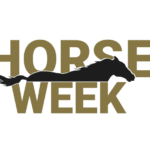Jan. 16, 2002 – The death of Bert de Nemethy is a loss for the sport he loved, and a personal one for me as well, since I visited him annually at his home in Sarasota, FL, and enjoyed a lively correspondence with him.
He combined the grace of his aristocratic upbringing in Hungary and the discipline he learned in the cavalry with a sense of humor and keen intelligence. That combination made him a unique figure, who became an icon in the horse world and was much-loved by those who knew him well.
Using the skills he had learned at the cavalry school in his native land and in European competitions, Bert honed Americans’ riding ability, crafting them into a style that was admired and copied around the world.
“Nobody who came under his influence is ever likely to forget the debt they owe him,” said USET Chairman Emeritus William Steinkraus, who won an Olympic individual gold medal, one of the high points of Bert’s quarter-century tenure with the team.
“He was very much of a leader and very much a gentleman of the old school,” said Frank Chapot, just named as the first coach of the USET show jumping squad since Bert retired two decades ago. While Bert was a believer in discipline, “if you were ever in trouble, he’d go to bat for you,” said Frank, who was a mainstay of U.S. teams in the Bert era, along with Kathy Kusner, Hugh Wiley, Joe Fargis, Conrad Homfeld and so many others. He improved everyone’s character, along with their riding.
Stadium Jumping Inc. Chairman Gene Mische, a close friend, noted “Many people have talked about how he introduced the present style in show jumping into the U.S. But one of his greatest contributions was really his integrity. You could count on Bert’s word 100 percent.”
The son of a governor in Hungary, Mr. de Nemethy started riding on the family farm in Gyor. A graduate of the Hungarian military academy in Budapest, he went to the Hungarian cavalry school, and then became an instructor there. Although he coached Olympic medallists, he never became one himself, since the 1940 Games for which he trained were cancelled when World War II began.
After coming to the U.S. in 1951 and working as trainer, he took over the U.S. show jumping squad in 1955. Upon sizing up the team, he told its leadership that the riders needed to travel to Europe for experience as they got ready for the 1956 Olympics.
“They accepted my recommendation, realizing that you cannot develop only in your own backyard,” he recalled when we talked about it years later.
“If you’re going somewhere else, you’ll discover someone much better than you are.”
European competition became a mainstay of his teams, who won their share of Olympic medals, Nations’ Cups and prizes in the world’s best grands prix.
But the fruits of the de Nemethy years were really reaped at the 1984 Olympic Games in Los Angeles, where he was the course designer. Only a short time after he retired from coaching, the Americans took their first team gold medal, and the individual gold and silver as well. It was the groundwork he laid that produced such success. His methods were outlined in his book, “The de Nemethy Method,” and a set of videotapes.
I once asked if he missed his old way of life in Hungary, a theoretical question of course, since it vanished in World War II.
But though he visited Hungary often, Bert’s allegiance was to the U.S., which had given him so much.
“If there had been no war,” he said, “I would probably be a former chief of the cavalry school or a retired general. Instead, my family lost everything it had owned for many hundreds of years. But I was lucky. I was one of the few people able to continue doing what I was best prepared for, and I have been pleased to have a lot of success.”
Then he added, “After all, this country offered me the chance my own country no longer was able to give me.”
Bert lived quietly near the end of his life in his beautiful home on Siesta Key. After the death of his devoted wife, Emily, in 1997, his fondest wish was to rejoin her, his true love. And now that wish is granted. He will be buried beside her in the family plot in Hungary. Memorial services in this country will be held next week in Sarasota.
Bert’s survivors include his sister, Maria Bobrovniczky and niece, Eszter Szabadhegyi, both of Budapest, as well as his step-daughter, Chrissy Ranelli of Newton, Mass., and her three children.
When I thanked Debbie Long, who took care of Bert after his wife died, I said how lucky he was to have had her.
“No,” she said, “it was my privilege,” and I knew just what she meant. There will never be anyone else like him. I feel so very fortunate to have been able to spend time with him. If I had to sum it up, aside from all Bert accomplished, I’d say he best could be characterized as a thoroughly delightful man.
A memorial service will be held for Bertalan de Nemethy at 5 p.m. on Tuesday, Jan. 22 at Selby Gardens, off Route 41 in Sarasota, Fla. Also memorialized at the service will be his wife, Emily, who died in 1997.





